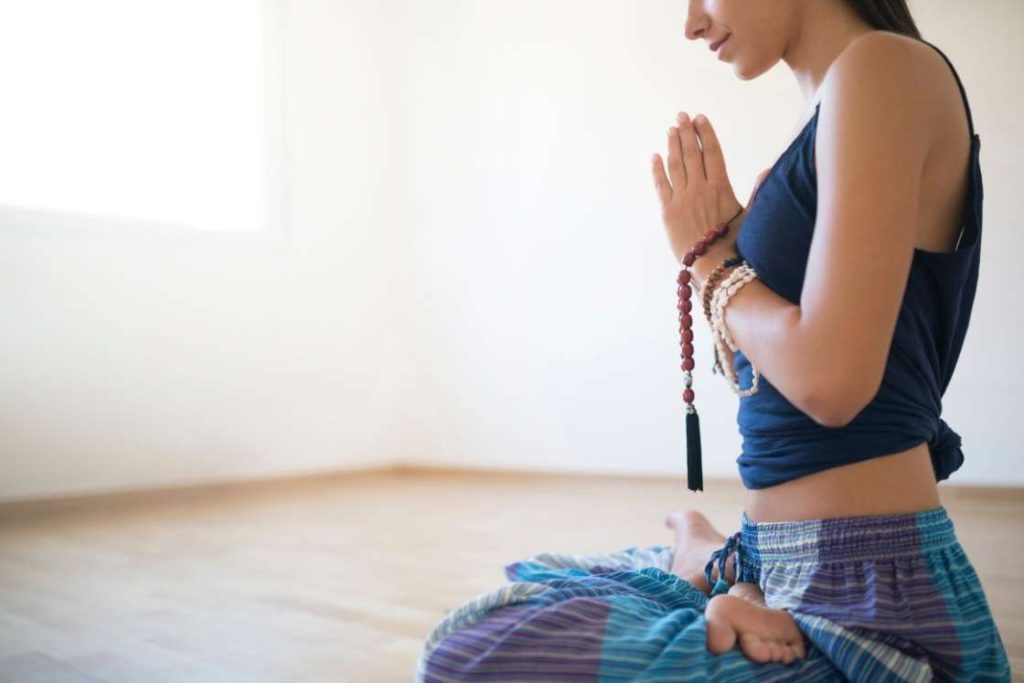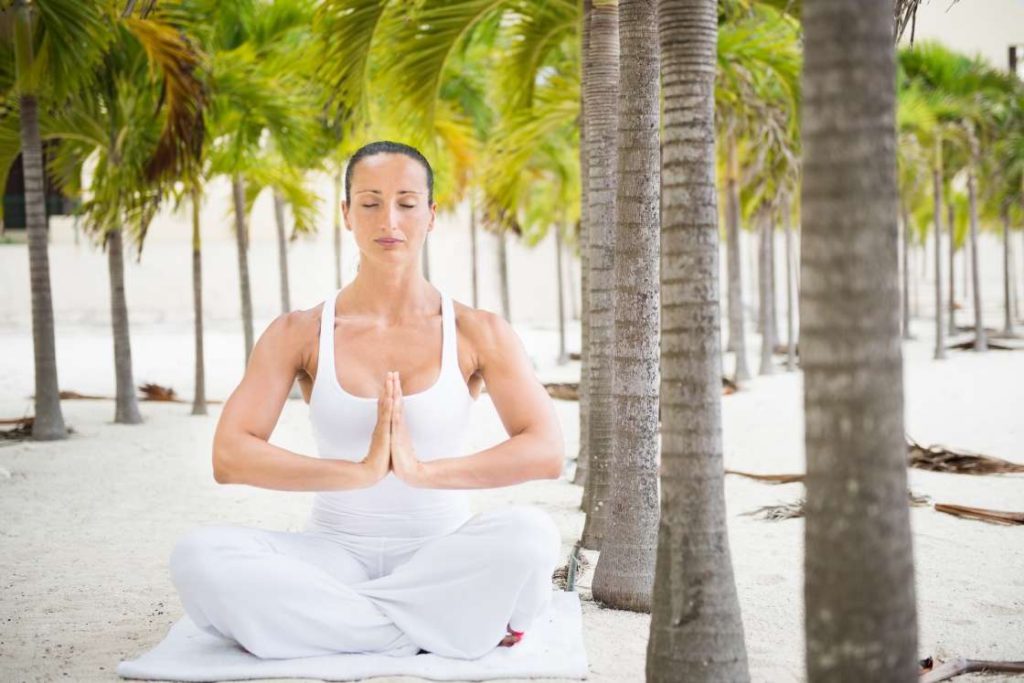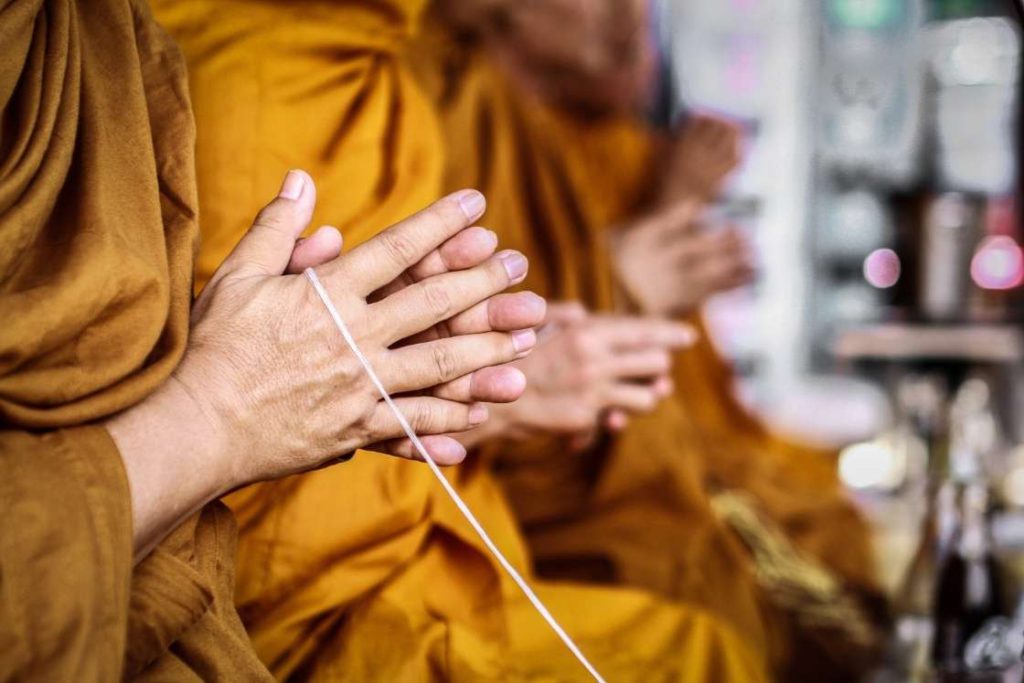- Definition
- Origin
- Parts of Mantra
- Mantra Yoga Limbs
- How to practice
- Mantra Chanting Types
- Mantra Yoga Benefits

Mantra Yoga is the practice of chanting sacred sounds, words, or verses to focus the mind and awaken higher consciousness. In Sanskrit, “man” means mind and “tra” means tool or vehicle, making the mantra a powerful instrument to guide mental energy.
Through regular chanting, practitioners harmonize their body, mind, and spirit, cultivating inner peace, clarity, and a deeper connection with the supreme consciousness.
What is mantra yoga?
Mantra Yoga is one of the six classical branches of yoga, focusing on the chanting of sacred syllables, verses, or Vedic hymns to attain inner control and higher states of consciousness, particularly the yoga limb of Pratyahara (withdrawal of the senses). Like all branches of yoga, its ultimate aim is self-realisation and spiritual liberation.
The term “Mantra Yoga” combines “Mantra” (a tool or sound to focus the mind) and “Yoga” (union with the supreme consciousness). Together, they form a practice designed to harmonise mind, body, and spirit.
Through disciplined chanting and repetition, the wandering mind becomes steady, allowing the practitioner to deepen meditation, connect with higher consciousness, and align fully with the intentions of yoga.
Origin of mantra yoga
Mantra Yoga finds its roots in the Vedas and Tantra, with its earliest teachings mentioned in the Rig Veda. In fact, some scholars suggest that yoga first developed through the practice of mantra chanting.
More than just a spiritual ritual, Mantra Yoga embodies a profound science passed down by the enlightened sages of Sanatana Dharma. Each mantra or hymn carries a unique vibration that resonates with universal consciousness, guiding the practitioner toward inner divinity and higher awareness.
While Mantra Yoga originated in Hinduism, its practice has also been embraced by Buddhism and Jainism as a means to attain enlightenment.
The repetition of sacred syllables or verses, known as Japa, deepens concentration and strengthens the effects of the practice. Because of this, Mantra Yoga is often referred to as Japa Yoga, highlighting the central role of consistent mantra chanting in spiritual progress.
The elements

Mantra Yoga is incomplete without understanding the essential elements of a mantra and the 16 limbs of the practice. These form the foundation for its successful implementation and spiritual benefits.
1. Parts of mantra
The five basic requirements of a Mantra are described below that include Rishi (Seer), Chhanda (meter), Devta (deity), Bija (seed), and Tattva (element).
- Rishi (Seer) – The seer or sage is the ancient spiritual teacher who discovered the mantra for the first time by hearing or realizing the sounds in higher consciousness. The sage then becomes a medium who passes the mantra to further followers in the world.
- Chhanda (meter) – A meter is something that describes the pronunciation, rhythm, and the way of recitation to please the deity associated with that mantra. Hence every mantra is prepared traditionally with a specific meter associated with it.
- Devta (deity) – Each mantra has a specific deity presiding over it who is called upon through the chanting. The practitioner by chanting the mantra attracts and assimilates the consciousness and qualities of the presiding deity.
- Bija (seed) – Bija is an essence of the mantra which grants special power to it. It is the seed of a mantra that enables the stimulation of the energy centers located in the human body. Therefore, bija is an essential element to see the fruition of the mantra.
- Tattva (element) – An element is a key to unlock the intended results behind the mantra. It can be understood by the fact that every mantra possesses the nature of a five-elements and one of 3 gunas (such as Sattva, Rajas, and Tamas).
2. Limbs of mantra yoga
Just like in Patanjali’s Yoga there 8 limbs which lead to Samadhi, there are 16 limbs of Mantra yoga knowing which is essential to get fruitful results from this practice.
The 16 limbs of mantra yoga are – Bhakti, Shudhi, Asana, Panchang Sevan, Achara, Dharna, Divyadesh Sevan, Prana Kriya, Mudra, Tarpana, Havan, Bali, Yaga, Japa, Dhayana, and Samadhi.
A clear idea describing all the limbs are given below to make the concept easier for the practitioner, so let’s begin:
- Bhakti – The foremost aspect of mantra yoga is having faith or devotion in the practice, that’s what bhakti denotes. It is impossible to manifest mantra yoga without having complete and unshakable faith over the practice.
- Shudhi – Shudi refers to purification, which in yoga mantra means internal cleansing of body, mind, and spirit. Also, the place dedicated to the practice and the intention behind it must be pure as well.
- Asana – Asana refers to the posture that the practitioner attains while practicing mantra yoga. It also denotes the seat on which the yogi sits like woolen, kusha, Resham, Mriga-charma, baghambar, blanket, etc. are considered preferable stuff to sit on.
- Panchang Sevan – It is the collection of Gita, Sahasranam, Stuti, Kavach, and Hridayanyas.
- Gita is the sacred text which is sung or taken excerpts from to chant.
- Sahasranam is experiencing the vastness of the supreme soul.
- Stuti refers to worshipping and associating the supreme being with the heart.
- Kavach denotes protection from the hurdles that are achieved by sadhana.
- Hridayanyas is entering the mysteries of the mantra through the heart.
- Achara – It shows the conduct of the practitioner behind the practice. It must have significant moral values and away from any bad influence.
- Dharana – This limb is about the concentration of the mind in the present moment.
- Divyadesh Sevan – It is about developing self-identification during the practice. It is achieved by establishing Prana Shakti (Energy) in 16 vital points of the body during the yoga mantra.
- Prana Kriya – The practice of regulating the breath by getting control over inhalation, retention, and exhalation is known as Prana Kriya or Pranayama.
- Mudra – It is the hand gesture describing devotional, aesthetic, emotional, or psychic attitude while chanting.
- Tarpana – It represents the libation or offering special ingredients, flowers, etc. to please the deity.
- Havan – This is the offering to the deity by burning the fire of Yagya, which represents feeding the lord in fire form. Mantra yoga cannot complete without Havan.
- Bali – Bali refers to sacrifice or surrender of negativity which are beyond control. It is performed by sacrificing evils like pride, lust, anger, and any other evil habits and practices.
- Yaga – This limb is about worshipping the deity wholeheartedly.
- Japa – It refers to repeated chanting of mantra as whispered, vocalized, or mental repetitions. Generally, a Mala with 108 beads are used to keep track of the rounds in Japa. Japa Mala could be of tulsi, rudraksha, rakta-chandan, shweta chandan, and crystal. It is used to keep the mind anchored to the practice.
- Dhyana – Higher and deeper state of concentration is meditation or dhyana, Here, it refers to image meditation, where the aspirant must be able to get a glimpse of the Lord on the third eye with closed eyes.
- Samadhi (trance) – Samadhi is the state of complete absorption of self with the supreme self. In this state, the practitioner realizes the eternal self aka akhand swaroop in Sanskrit.
How to practice mantra yoga?

To practice mantra yoga, the important step is to draw honesty (Satya) into the practice that signifies the dedication of the practitioner.
Another thing that has to be there before starting the chant is to surrender in the mantra which can be done by trusting in the practice. It is the faith in the practice that leads to the intended results which seem far beyond one’s potential.
After honesty and faith within yoga mantra, the following procedure can be followed to implement the practice:
- Find a comfortable place that is away from any distractions or disturbances to practice seated meditation.
- Choose your mantra and then sit quietly for a moment contemplating your intentions with a conviction.
- Inhale deeply and then while exhaling recite your mantra as naturally as it rhymes with the exhalation.
- Take another deep breath and repeat the mantra and feel the moment organically.
- On the third repetition, recollect the intention behind the particular mantra that you are chanting.
- On the fourth repetition, you need to relax the mind and body and feel the sound of the mantra.
- On the next repetition, let the chant happen automatically with the flow where you don’t utter it forcibly.
- Repeat again and again combining all the elements together focusing on the sound and meaning of the mantra and easing your expectations.
- Keep chanting for about 30 rounds or until you calm the mind within the practice.
- Sit in complete silence for a while that you have generated with the chant cleansing the nervous system.
Alternatively, mantra yoga can also be done in a group aka Sangh wherein one leader introduces the mantra to the rest of the assembly.
Types of chanting in mantra yoga

There are 14 types of chanting in Mantra Yoga, out of which three are considered superior or popular among all the practitioners, namely, Speech Chanting (Baikhari), Low-pitched Chanting (Upanshu), and Mental Chanting (Manasic).
Let’s have a glance at all the 14 types of chanting in mantra yoga as given below:
- Speech Chanting – It is the practice of chanting the mantra loudly to focus completely over the sutra and its resonating sound. It removes undesirable thoughts, stabilizes the mind to reach meditative states, especially helpful for a beginner.
- Low-pitched Chanting – It is a way of mantra yoga that is audible to the practitioner only as the chant is vague that only involves lip-movement while recitation.
- Mental Chanting – Here, the mantra is chanted silently in the mind without actually uttering it through the mind. This is usually practiced by advanced or enlightened yogis.
- Nitya Japa – It is the practice of mantra yoga which is performed every day with consistency.
- Kamya Chanting – When the yogi practice Japa yoga for the sake of their own desires, then it is Kamya chanting.
- Naimitik Chanting – Here, the practice is focused on someone else’s favor or sake.
- Immovable Chanting – As the name clears it all, in this type, the sound limbs or mouth do no move at all. The mantra is recited internally and it is practiced by bringing the body in complete stillness.
- Atonement Chanting – When mantra yoga is adapted for atoning or to get rid of some crime, offense, or sins that incurred to mind accidentally, then such chanting is known as atonement chanting.
- Running Japa – This is the practice of mantra yoga where the chant continues while sitting, eating, sleeping keeping the tongue and lips in motion. It can also use a garland that also moves around the fingers while chanting.
- Akhand Chanting – In this practice, the chanting continues without any break or intervals in between.
- Ajapa Chanting – This is a method of practicing mantra yoga that doesn’t involve any effort, as the chant occurs in a flow just like breathing. Therefore, such chant takes place as long as there is prana or breath in the body.
- Bhramar chanting – Here, the mantra chanting is done imitating the humming of a bee.
- Pradakshina Chanting – Pradakshina is a sacred rotation around a temple, deity, or any sacred grove. So, the chanting that is practiced while doing the pradakshina is known as pradakshina chanting.
- Prohibited Chanting – When someone intends to harm others or chant with an impure intention that doesn’t have any rhythm or is very intense, then it is prohibited chanting. Such chanting is totally fruitless.
Benefits of mantra yoga
Mantra yoga is a great practice synchronizing the body, mind, and soul. Mantras that are chanted in this practice are associated with sacred powers and the hymns or vibrations have certain effects on the body’s energy centers, thus there are numerous benefits arising from mantra yoga.
These help to uplift the energy states improves well-being and enhances the manifestation of yoga. The major benefits of mantra yoga are listed below.
- Each mantra has its own vibration which helps in cleansing the body internally, i.e. targets the cleansing of negative emotions like jealousy, arrogance, fear, or confusion.
- Mantra yoga is an effective practice to harmonize the Doshas (Vatta, Pitta, and Kapha) and stimulates the flow of Amrita (nectar of divine bliss) from crown chakra towards the root chakra.
- It increases the sense of awareness, concentration levels, and control over the mind.
- Chanting a mantra with dedication and concentration helps the practitioner to absorb the qualities of the presiding deity of that particular mantra.
- While practicing mantra yoga, the mind revolves around the hymn and the positive vibrations that help in harnessing mindfulness. Thus, it helps in inculcating positivity within the practitioner towards life and the world around him.
Conclusion
Yoga mantra is your go-to practice if you want to take your yoga into next level getting control over your mind. In this hectic and stressful lifestyle mantra yoga is a blissful and sacred practice that unlocks real happiness, positivity, and coordinates the mental and physical health.
Have faith while practicing mantra yoga and achieve everything in life experiencing the protection from the supreme soul and take your yoga journey into advance levels.





I appreciate the honesty in your assessment — refreshing to see.